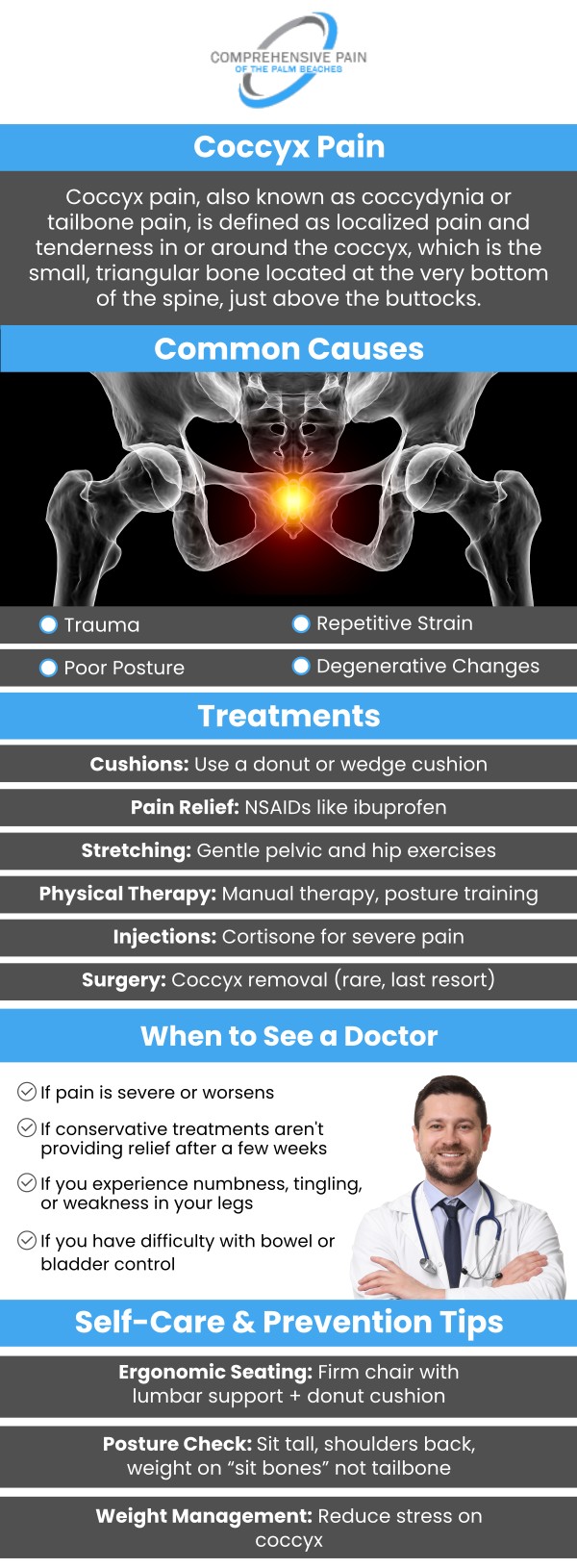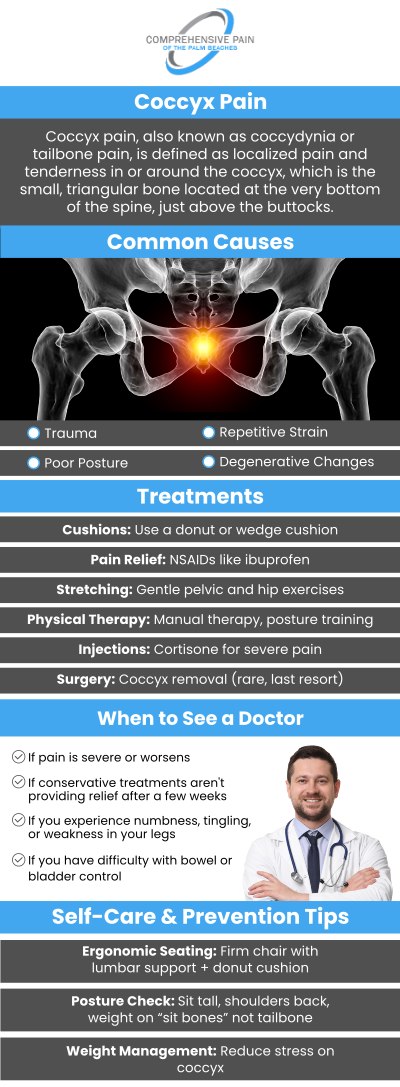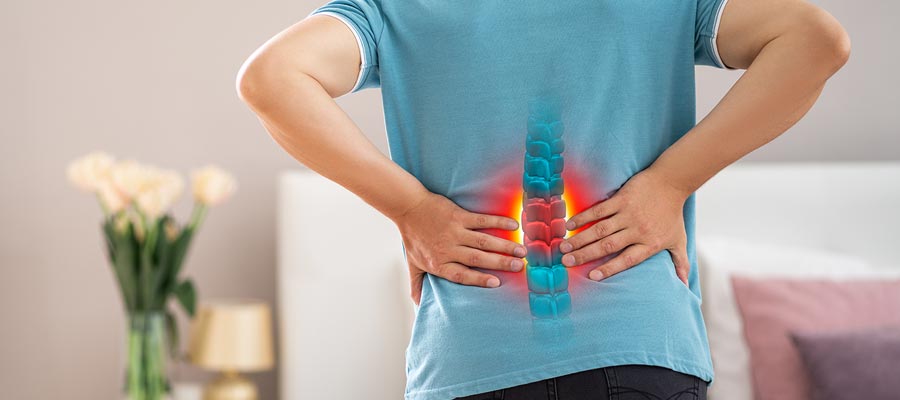Understanding the Causes of Coccyx Pain and How to Treat It
Coccyx pain, or tailbone pain, can arise from a variety of factors, including prolonged sitting, trauma, or poor posture. It may also result from pregnancy or certain medical conditions. Effective treatment involves a combination of posture adjustments, physical therapy, and pain management strategies. At Comprehensive Pain of the Palm Beaches, our team offers tailored care to address the underlying causes of coccyx pain and provide relief. For more information, contact us or book an appointment. Our clinics are conveniently located in Greenacres, FL, and Port St. Lucie, FL.




Table of Contents:
What causes coccyx pain, and how can it be treated?
How do I know if my tailbone pain is caused by coccyx pain?
What are the most common symptoms of coccyx pain?
Can sitting for long periods cause coccyx pain?
Coccyx pain, also known as coccydynia, is discomfort or pain in the tailbone area, which is located at the very bottom of the spine. Several factors can cause coccyx pain, and treatment options vary depending on the underlying cause.
Common Causes of Coccyx Pain:
1. Prolonged Sitting: Sitting for long periods, especially on hard surfaces, can put pressure on the tailbone and lead to pain. This is common among people who spend a lot of time sitting at desks or driving.
2. Trauma or Injury: A fall or direct injury to the tailbone, such as during childbirth or from an accident, can cause bruising, fractures, or dislocations in the coccyx, resulting in pain.
3. Poor Posture: Poor posture, especially when sitting or standing, can place excess pressure on the coccyx and lead to discomfort over time.
4. Childbirth: Women who have recently given birth may experience coccyx pain due to the pressure exerted on the area during delivery.
5. Obesity: Increased body weight can add additional pressure on the tailbone, leading to pain when sitting for long periods.
6. Coccygeal Bursitis: Inflammation of the bursa (a fluid-filled sac) near the tailbone can cause pain, particularly when sitting.
7. Degenerative Conditions: Conditions like arthritis or degenerative disc disease can affect the joints and ligaments near the coccyx, leading to pain.
8. Infections: Infections such as pilonidal cysts can cause swelling and pain around the tailbone.
Treatment Options for Coccyx Pain:
1. Pain Relievers: Over-the-counter medications like ibuprofen or acetaminophen can help reduce inflammation and manage pain.
2. Cushions and Proper Seating: Using a cushion with a cut-out area for the tailbone while sitting can reduce pressure and alleviate discomfort. It’s also important to take frequent breaks from sitting.
3. Ice or Heat Therapy: Applying ice packs to the area during the first 48 hours after injury can help reduce inflammation. After that, heat therapy can help relax muscles and alleviate pain.
4. Physical Therapy: Specific exercises and stretches can help improve posture, strengthen the muscles around the tailbone, and relieve pain.
5. Injections: For persistent pain, corticosteroid injections may be used to reduce inflammation and provide temporary relief.
6. Manual Manipulation: In some cases, healthcare providers may perform a gentle manual manipulation of the coccyx to help alleviate pain and restore proper alignment.
7. Surgery: In rare cases where conservative treatments do not provide relief, surgical removal of the coccyx (coccygectomy) may be considered, particularly if the pain is debilitating.
If you experience persistent or severe coccyx pain, it’s important to seek medical attention to determine the exact cause and get a treatment plan tailored to your needs.
Our expert team is skilled in identifying the unique characteristics of coccyx pain, which typically manifests as sharp or aching discomfort at the base of the spine, just above the buttocks. Patients often report increased pain while sitting, particularly on hard surfaces, or during transitions from sitting to standing. Recognizing these patterns can be crucial for an accurate diagnosis.
If you’ve recently experienced trauma such as a fall, childbirth, or repetitive strain from activities like cycling, these factors may contribute to coccydynia. Our specialists can help identify if a specific event is linked to your pain and develop a tailored treatment plan.
In some cases, visible signs such as swelling or bruising may accompany coccyx pain. However, even in the absence of these signs, persistent pain should not be ignored. We recommend seeking a professional evaluation if your symptoms persist, worsen, or if you experience additional symptoms such as numbness, tingling, or changes in bowel or bladder function.
At Comprehensive Pain of the Palm Beaches, we offer comprehensive evaluations that include physical examinations, detailed medical history reviews, and, if necessary, advanced imaging tests to confirm a diagnosis.
At Comprehensive Pain of the Palm Beaches, we understand that coccyx pain, or coccydynia, can significantly impact your quality of life. Our team is dedicated to providing tailored care to address the unique symptoms and challenges associated with this condition. Coccyx pain often presents as localized discomfort at the base of the spine, and while it can vary from a dull ache to a sharp, stabbing sensation, it frequently intensifies during prolonged sitting or transitions from sitting to standing.
The most common symptoms of coccyx pain (coccydynia) include:
1. Pain When Sitting: The most characteristic symptom of coccyx pain is discomfort or pain when sitting, especially on hard surfaces or in certain positions. The pain can range from mild to severe and may improve when standing or walking.
2. Tenderness: The area around the tailbone may feel tender to the touch. Pressing on the coccyx or the surrounding area can cause pain or discomfort.
3. Pain While Transitioning Positions: Moving from sitting to standing, or vice versa, can trigger or worsen the pain in the tailbone area.
4. Pain During Bowel Movements: Some individuals experience increased pain when defecating due to pressure on the coccyx during this time.
5. Localized Pain: The pain is typically located at the base of the spine, near the tailbone. It may feel like a dull ache or sharp, shooting pain.
6. Pain When Bending or Lifting: Certain movements, like bending over or lifting heavy objects, may aggravate coccyx pain due to increased pressure on the tailbone.
7. Increased Pain with Prolonged Sitting: Sitting for extended periods, especially on hard surfaces, may exacerbate the pain.
The symptoms can vary in intensity and duration depending on the cause of the coccyx pain. If the pain persists or worsens, it is important to consult a healthcare provider for a proper diagnosis and treatment plan.
Sitting for long periods, especially on hard surfaces, can cause coccyx pain (coccydynia). Prolonged sitting places pressure on the tailbone (coccyx), which can lead to discomfort or pain. This is particularly common for people who sit at desks for long hours, drive frequently, or engage in activities that involve extended sitting.
The pressure on the coccyx can irritate the surrounding muscles, ligaments, and tissues, leading to inflammation and pain. Poor posture while sitting can also contribute to coccyx pain by adding additional strain on the tailbone area.
To help prevent or alleviate coccyx pain caused by prolonged sitting, it’s important to take regular breaks, use a cushion with a cut-out for the tailbone when sitting, and ensure proper posture to reduce pressure on the area.
If you are experiencing coccyx pain, don’t let it diminish your quality of life. Contact Comprehensive Pain of the Palm Beaches to schedule a consultation and learn more about how we can help you manage and alleviate your pain effectively. Addressing coccyx pain early can prevent it from worsening and significantly enhance your overall comfort and well-being. For more information, contact us or book an appointment. Our clinics are conveniently located in Greenacres, FL, and Port St. Lucie, FL. We serve patients from Port St. Lucie FL, Stuart FL, Palm City FL, Greenacres FL, Palm Springs FL, Boynton Beach FL, and surrounding areas.
Check Out Our 5 Star Reviews



Additional Services You May Need
▸ Knee Pain
▸ Arthritis
▸ Back Pain
▸ Neck Pain
▸ Neuropathy
▸ Headaches
▸ Nerve Damage
▸ Fibromyalgia
▸ Chronic Pain
▸ Osteoporosis
▸ Muscle Injuries
▸ Pinched Nerve
▸ Diabetes Pain
▸ Herniated Disc
▸ Pain After Surgery
▸ Mere Conditions


